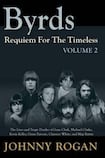
The good thing about Johnny Rogan is he’s forensic to the point of obsessive. This is also the bad thing about Johnny Rogan. His books are closer to Warren Reports than standard rock biographies, immense things, doorsteps, exhaustive in their near-obsessive detail. The corollary is that the reader is often left wanting some sense of the pure joy in the music produced by his subjects. The Smiths, The Kinks, Van Morrison – all have gotten Roganised, and each work has emerged as an exercise in examining the pettiness of human nature and the fallibility of musicians as much as an exploration of the mystery and magic of popular art.
Therefore it's somewhat of a relief to report that Rogan is not only evangelical about the Byrds' music, but quite likes the personalities involved as well. Requiem For the Timeless Volume 2, the sequel to his epic study of the Byrds' mothership, published in 2011, is essentially a collection of (not so) mini-biographies of the band's supporting cast and cameo personnel. Some of these individuals were prominent in their own regard (most notably Gene Clark and Gram Parsons), some all but vanished from public life after leaving the band, and some sentenced themselves to a half-life of playing with dubious tribute acts masquerading as legitimate reformations, reduced to endless one-nighters and small-time festivals.
Gene Clark commands the longest of these biogs-within-a-biog, not least because he's a fascinating and complex study. Accounts of his early years testify to a character who was intermittently tough and tormented, a wastrel and a homebody, witty then withdrawn, physically formidable but with a poetically doomed cut to his jib. In other words, Clark was the Byrds' version of Townes Van Zandt, given to cosmic prolixity (Echoes, Set You Free This Time), but also a gifted tunesmith (Feel A Whole Lot Better, She Don't Care About Time).
A Missouri boy who migrated to Californian territories, Clark in his prime was rated a superior songwriter to his bandmates Roger McGuinn and David Crosby by no less than Dylan. But, ultimately, his is a classic Icarus tale of squandered talent and blown chances, a litany of drink and drug binges with Hollywood buddies, crash and burn romances, shambolic shows and patchy albums, a sort of country-rock Johnny Thunders.
Gram Parsons by contrast has been biographized to death, a charismatic little Lord Byron whose background is often described as classic southern gothic. The son of a Georgian dynasty, Parsons grew up among privilege and tragedy: his father took his own life when he was a boy and his mother drank herself to death in her early 40s.
Essentially a trust-fund brat with a bohemian bent and a heart-melting voice, Parsons treated money and success with insouciance, but after his stint with the Byrds during their country-rock prime (Sweetheart of the Rodeo), his career was bedevilled by self-sabotage and numerous wasted opportunities. Neither the International Submarine Band nor the Flying Burrito Brothers managed a consistent album between them (all the more frustrating when one considers individual songs like the exquisite Hot Burrito #1), and after The Gilded Palace of Sin, Parsons blundered into a haze of late 60s esoterica, stoned desert sorties, mescaline, pot, coke and booze. He schooled the Stones in country roots but, like so many others, got his wings singed by his association with Keith Richards, ending up overweight and addicted to heroin.
A collaboration with the young Emmylou Harris provided momentary salvation in the form of the Grievous Angel album, but Parsons' final days read like Hunter S Thompson: a morphine overdose, then the bizarre hijacking of his body by road manager Phil Kaufman (who maintained he was fulfilling a pledge he'd made to cremate the body at Joshua Tree in the Mojave). All this is old news to Mojo readers, but the author's relentless attention to detail breathes new life into the old myth, particularly his redressing of Gram's stepfather Bob Parsons' reputation, who Rogan feels has been impugned by previous biographers.
By contrast the minor players in the tale are compelling more because of where they were than who they are. Which is not to denigrate their contributions to the band’s music, but only a writer such as Rogan would devote several hundred pages (plus extensive footnotes, index and discography) to what is ostensibly a supporting cast, many of whom ended their careers breathing the fumes of old glories. There was easy-going drummer Michael Clarke, who’d left the band by the age of 21, and was dead by 47; his replacement Kevin Kelley, the child of a divorce who joined the Marines and served as a cryptographer before becoming a musician, and who subsequently vanished from public life, spending his last days bloated and in penury; Clarence White, a low-key character and a gifted country-rock session guitarist struck dead by a drunk driver at the age of 29; and Skip Batten, a seasoned journeyman and one hit-wonder before he joined the Byrds, and one of the few among this cast who seems to have had his head screwed on, playing out his later years as a jobbing musician and berry farmer with a sort of cheerful resilience, the quintessential easy-going bass player, until Alzheimer’s forced him to retire.
This book is not for the casual reader. It's for Byrds fanatics. If not for the sheer beauty of the music produced by these individuals, Requiem For the Timeless Volume 2 might read like yet another tale of alcoholic man-children being followed around by fools of enablers and indulgers, with tragic consequences. It's the oldest one in the artist's handbook: how can such train wrecks produce such beauty? That riddle might never be solved, so one is left with no option but to return, again and again, to the Byrds' intoxicating sounds.
Peter Murphy is the author of the novels “John the Revelator” and “Shall We Gather at the River”, published by Faber & Faber










